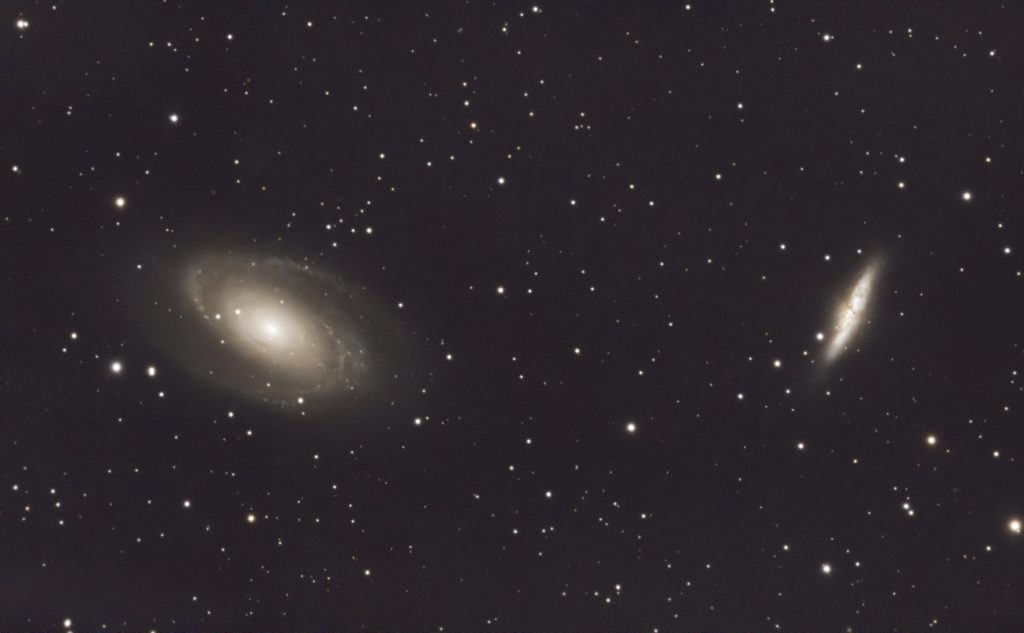
While star clusters and many nebulae are relatively large and bright objects for visual observing, galaxies are a different matter. A side from the Magellanic Clouds, only two shine bright enough to see without optics, the Andromeda Galaxy and the Triangulum Galaxy, and most are far fainter. But with a little optical aid, dozens of galaxies pop into view. Charles Messier, who mostly observed with a 4″ refractor in 18th century France, catalogued 40 galaxies in his original list of 103 deep-sky objects, although he had no idea as to their great distance and nature as distinct ‘island universes’.
With dark sky, we can see all 40 of Messier’s galaxies, and many more, visually with a 2″ telescope or even a pair of binoculars. But seeing much detail in any of them is extremely difficult without at least a 6″ or preferably a 10″ telescope scope. But when a camera (and some computational power) replaces the eye, well, that’s a different story. Modern CMOS astronomy cameras are extremely sensitive to faint light from astronomical objects, while processing techniques can tease out contrast and even out sky gradients caused by light pollution and the moon.
A new crop of automated telescopes for backyard stargazers incorporates these features and adds go-to capabilities to make it easy to take snapshots of all sorts of celestial objects, from the moon to nebulae and galaxies. Many such instruments features small apertures, including the Seestar 50 telescope from ZWO that has a 50mm objective lens with a focal ratio of f/5, along with a relatively simple camera system originally intended for planets and plenty of processing power under the hood. The little telescope reminds me of the robot R2D2 of Star Wars fame. And while it won’t produce award-winning photos of the kind taken with more complex and expensive rigs, it’s lots of fun to use. So, as another northern spring gets (haltingly) under way, I’ve undertaken many tours of some of my favorite spring galaxies in and around Leo, Virgo, and Ursa Major. In this tour we have a look at a few favorites.
M81 and M82
We might as well start with a couple of showpiece galaxies, the famous grand-design spiral Messier 81 and its neighbor, the irregular spiral Messier 82 in Ursa Major (see image at top). The pair lie about 11 million light years away, close for galaxies, and comprise the brightest members of the M81 group of galaxies they adorn this patch of sky around the Big Dipper and Camelopardalis. The are gravitationally to each other, and M82 in particular is wracked by a bout of intense star formation likely started by a nudge from its larger neighbor. It’s sometimes called the Cigar Galaxy, while the elegant M81 is called Bode’s Galaxy after its discoverer Johann Bode who noted it in the late 18th century.
The Whale and Pup and Hockeystick Galaxies
Moving further afield into intergalactic space to a distance of some 30 million light years, we see a pair of galaxies pairs with striking shapes under the Big Dipper’s handle in the constellation Canes Venatici. Like M82, the wedge-shaped galaxy NGC 4631 is undergoing a rapid bout of star formation triggered by its small companion NGC 4627. The two irregular galaxies call to mind a whale and pup swimming through space. NGC 4631 anchors a small and ill-defined galaxy group that includes NGC 4656 and NGC 4657 which together resemble a hockey stick just half a degree southeast. The larger galaxy here is a mangled barred-spiral bent out of shape by interaction with its companion and with NGC 4631. A strange-looking collection of galaxies here, but very photogenic.
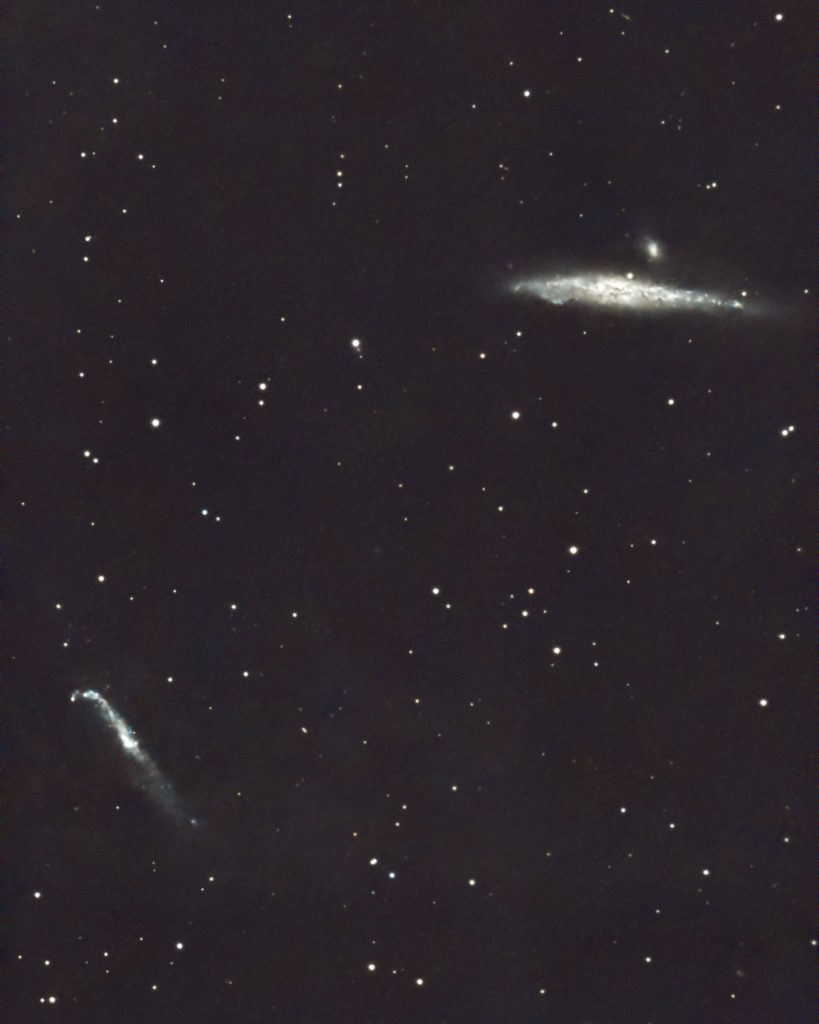
The Leo Triplet
The constellation Leo is stuffed with galaxies that are visible in a backyard telescope and nicely within reach of a little smart scope like the Seestar 50. Three of the brightest and best known are M65, M66, and NGC 3628, also known as the “Leo Triplet”. You can see all three galaxies in virtually any telescope and even in a good pair of binoculars. If you can see all three galaxies at once, keep in mind you’re seeing at one time the collected light of more than half a trillion stars! The trio lies about 35 million light years away. M65 appears a bright oval with a clearly defined core and with faint extensions visible with averted vision that give the galaxy a distinctive “S” shape elongated north-south. M66 lies just 1/3 of a degree east-southeast of M65. The total brightness of M66 is slightly greater than M65, but the former appears fainter to most observers because it’s more spread out. NGC 3628, the third member of the triplet, has magnitude of 9.5, just a tiny bit fainter than M65 but it’s far more spread out; the low surface brightness makes it a challenging sight for visual observing. Because if its prominent central dust lane, it’s often called the ‘Hamburger Galaxy’. Like M82 and NGC 4631, NGC 3628 is also a ‘starburst’ galaxy.
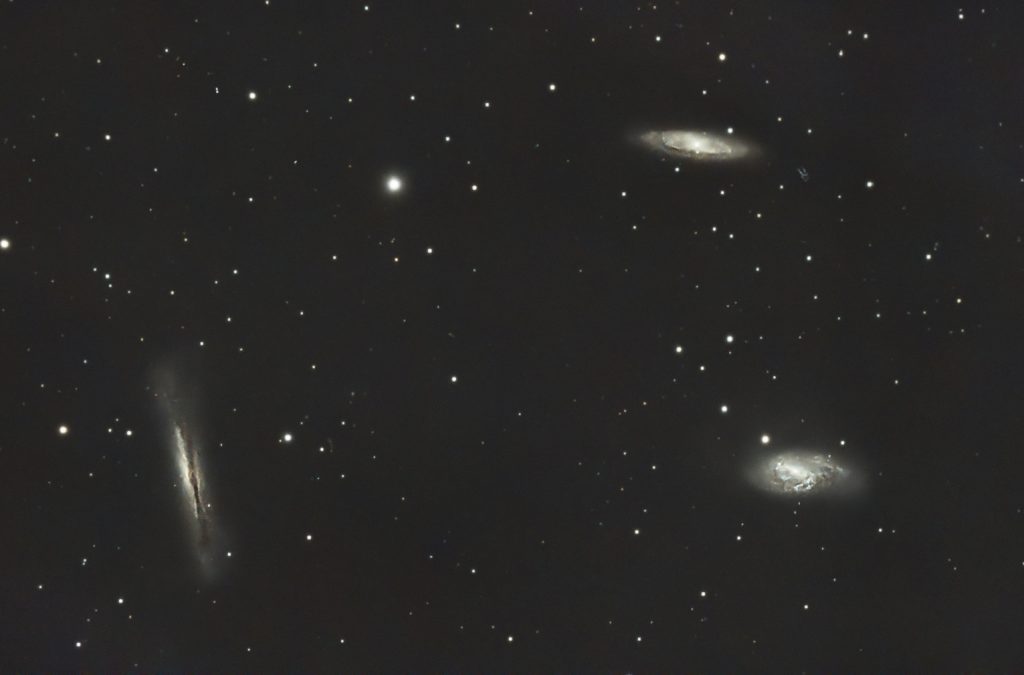
The Whirlpool Galaxy
The showpiece of this area is M51, the Whirlpool Galaxy, which interacts gravitationally with the nearby galaxy NGC 5195 just 3º southwest of Alkaid, the tip of the Big Dipper’s handle. M51 is an elegant face-on spiral galaxy just 15 million light-years away. NGC 5195 is a dwarf elliptical distorted by its more massive companion. A bridge of stars connects the two galaxies.
Lord Rosse was the first to glimpse the spiral structure in M51 with his massive telescope in the Irish countryside in the mid-19th century. The Whirlpool, like many face-on spiral galaxies, was once thought to be a new solar system forming within our own galaxy. Once Edwin Hubble established the distance to the Andromeda Galaxy in 1929, astronomers understood these objects were separate galaxies in their own right. M51 is some 15 million light years away and spans 50,000 light years, about half as much as our own Milky Way.
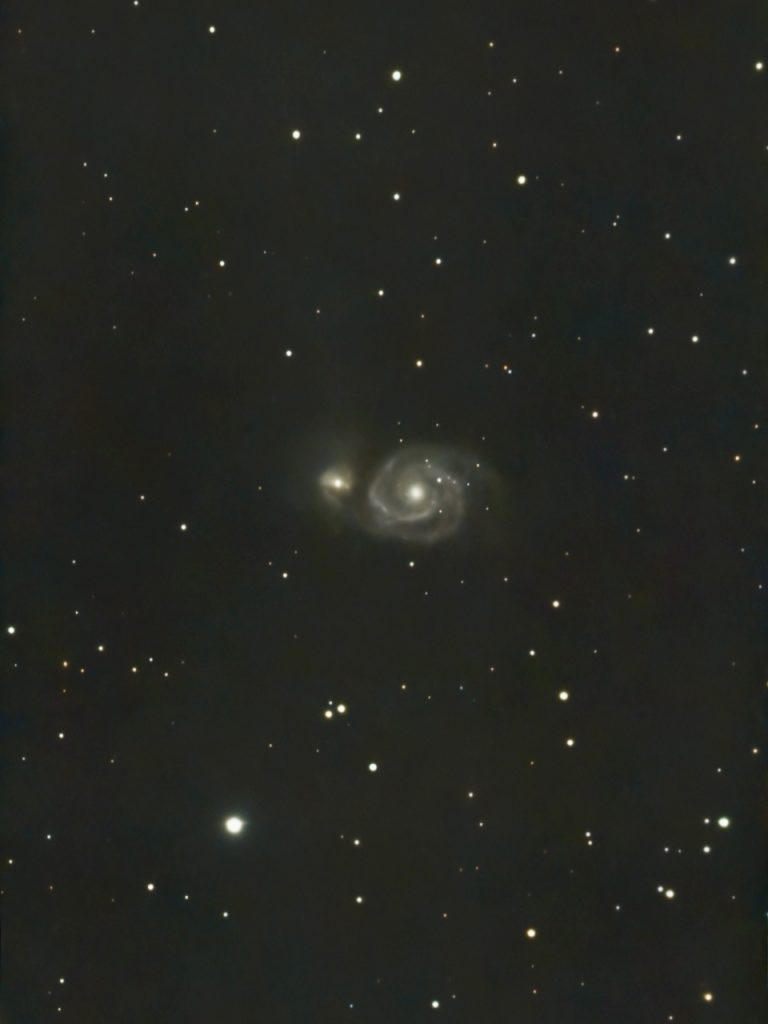
M106 and the Owl Nebula Galaxy
Now I turn the little Seestar 50 to two objects near the star Merak, just under the bowl of the Big Dipper. The first object is another mottled, needle-shaped galaxy M108 that resembles M82. At magnitude 10.0, the galaxy is much fainter and smaller than M82, but it’s still visible in a 3-inch scope in dark sky because of its relatively high surface brightness. Like M82, M108 is or has recently experienced a bout of star formation, which accounts for its disheveled appearance. This spiral galaxy is small, about 1/5 to 1/10 the mass of the Milky Way, and lies about 45 million light years away in the Ursa Major Group of galaxies.
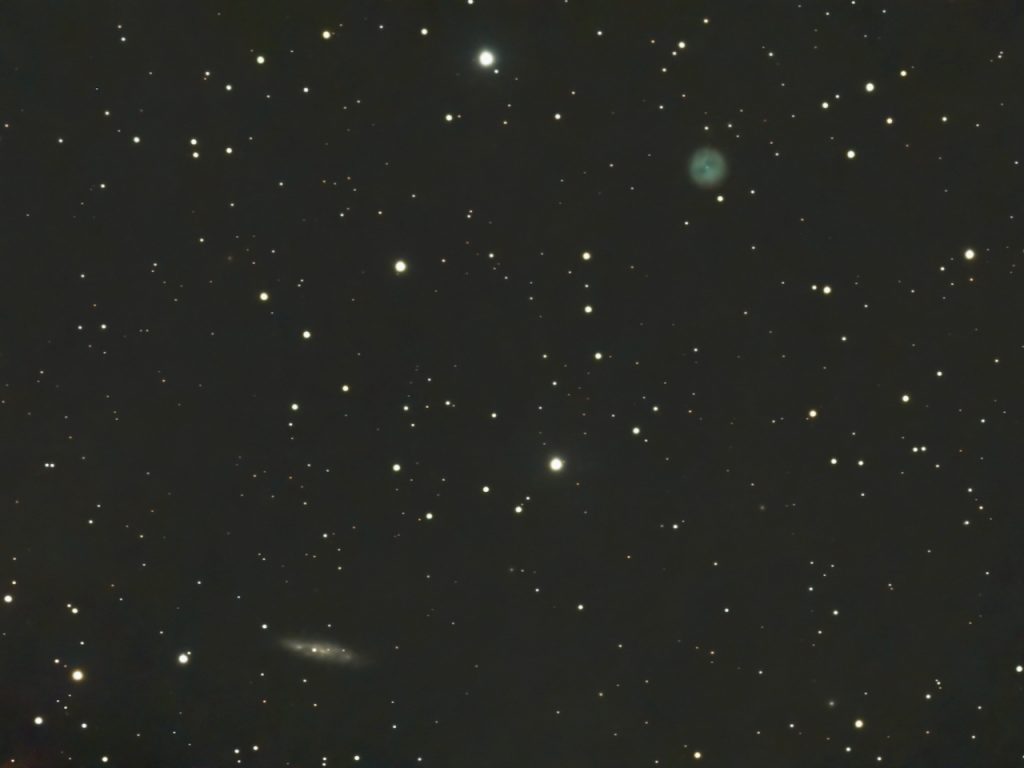
Less than a degree to the southeast of M108 lies a most intriguing planetary nebula, the famous Owl Nebula. A young planetary nebula just 6,000 years old, M97 is a speeding cloud of glowing gas ejected by a small dying star. In a small scope under dark sky, the nebula resembles the eyes of wise old barn owl gazing out of the interstellar darkness. It’s a challenging object for visual observers, but the Seestar pulls it out of the light pollution nicely. The central star casting off the nebula shines at a dim 14th magnitude, a challenge even in a 10″ scope visually, but it’s easily visible in the image above. The Owl belongs to our own galaxy and lies just 1,600 light years away, while M108, a member of the Ursa Major galaxy cluster, lies at a distance of 45 million light years.
Share This: